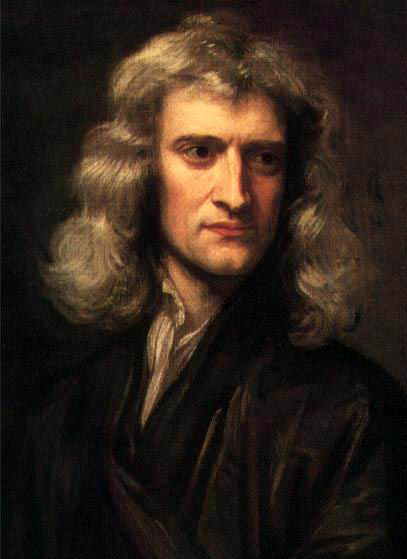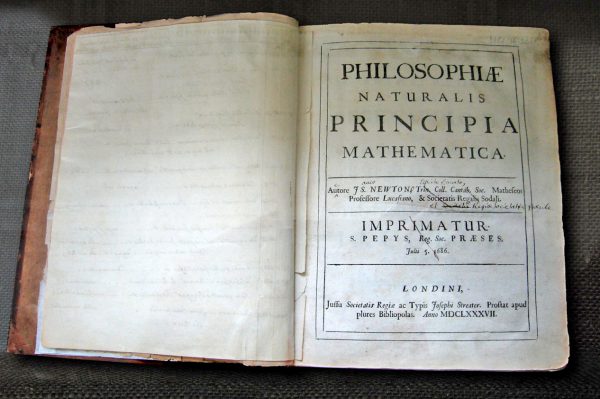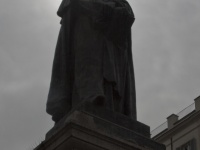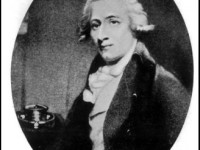
Sir Isaac Newton (1642 – 1727)
On July 5, 1687, Sir Isaac Newton published his Philosophiae Naturalis Principia Mathematica (in Latin). The Principia states Newton’s laws of motion, forming the foundation of classical mechanics; Newton’s law of universal gravitation; and a derivation of Kepler’s laws of planetary motion (which Kepler first obtained empirically).[6] It is to be considered as the most influential work of Isaac Newton and as one of the greatest scientific works of all time.
“The ancients considered mechanics in a twofold respect; as rational, which proceeds accurately by demonstration, and practical. To practical mechanics all the manual arts belong, from which mechanics took its name. “
– Isaac Newton, Philosophiae Naturalis Principia Mathematica (1687)
By Impulse of Edmond Halley
The original impulse to work on the Principia gave Edmund Halley,[2,3] the English scientist known for his calculations on the orbits of comets and for being the second Astronomer Royal in Britain. In 1684, Newton send him the treatise On the motion of bodies in an orbit which contained the derivation of Kepler’s laws and was lectured at the Royal Society by Halley. After gaining interest and respect by the Society, Newton was convinced to publish his work and was supported by the former Astronomer Royal John Flamsteed though receiving data from observations of the planets.[4] Edmond Halley presented the final version of the Principia to the Royal Society in June of 1686, impressed by Newton’s work, the Society pledged for a quick release of the writings receiving printing permission from Samuel Pepys on 5 July 1686.[10] Still Halley had to pay for the publishing costs, since the budget was completely consumed by Willughby’s work ‘De Historia Piscium‘ (honestly, does anyone remember this book?).
The Principia – Combining Galilei and Kepler
“Every body continues in its state of rest, or of uniform motion in a right line, unless it is compelled to change that state by forces impressed upon it.”
– Isaac Newton, Principia Mathematica (1687), Laws of Motion, I
In his work, Newton combined Galileo Galilei‘s theories on acceleration and Kepler’s laws to the theory of gravitation [5], which was the foundation of classical mechanics. Also he was able to influence the later studies of Albert Einstein‘s theory of relativity through introducing the concepts of absolute time and space as well as action at a distance [1]. The entire writing was published in three books. The first two books are rather mathematical, containing the derivations of Newton’s laws of motion and the motion of objects in viscous fluids. The third book was written with the intention of making these mathematical theories understandable for the masses through explaining their application on actual movements of celestial bodies.

Isaac Newton’s own first edition copy of his Philosophiae Naturalis Principia Mathematica with his handwritten corrections for the second edition, photo: wikicommons
Besides…
“Hypotheses non fingo.” (I frame no hypotheses.)
– Isaac Newton, Principia Mathematica (1687), 3rd edition
Next to the Pricipia, Newton was also active in the field of optics, whereof he gave lectures in the 1670’s. He published his theory of colour and created the Newtonian telescope based on a mirror optics. Newton also completed notable works in the field of religion. He dealt with trying to interpret the Bible literally and saw in God a creature, whose existence could not be disproved, and a masterful creator. Nevertheless Newton was not known for being an orthodox Christian, even though he had grown up in an Anglican family.
The Second Edition
“We are to admit no more causes of natural things than such as are both true and sufficient to explain their appearances.”
– Isaac Newton, Principia Mathematica (1687), “Rules of Reasoning in Philosophy” : Rule I
From 1709 Newton, with the substantial support of Roger Cotes, Plumian Professor of Astronomy at Trinity College [11], worked on a second edition of the Principia, published in 1713, with an extensive and enlightening preface by editor Cotes, agreed with Newton. At that time Newton was employed as head of the Royal Mint and, incidentally, was involved in various priority disputes, particularly with Gottfried Wilhelm Leibniz.[12] In a “General Scholium” at the end of Book 3 in this second edition, he criticizes Descartes and Leibniz. Here is also his famous statement that he would not form hypotheses (“Hypotheses non fingo“). The third edition was published on 25 March 1726 with the collaboration of Henry Pemberton (Newton praisingly mentioned in the preface this time).
Robin Wilson and Raymond Flood, The World of Isaac Newton, [13]
Further Reading:
- [1] The Annus Mirabilis in Physics – Albert Einstein and the Year 1905, SciHi Blog, June 30, 2012.
- [2] Edmond Halley besides the Eponymous Comet, SciHi Blog, November 8, 2015.
- [3] Sir Edmond Halley and his Famous Comet, SciHi Blog, November 8. 2012.
- [4] John Flamsteed – Astronomer Royal, SciHi Blog, March 5, 2014.
- [5] Christmas Trilogy 2017 Part 1: Isaac the Imperator, at The Renaissance Mathematicus, Dec 25, 2017.
- [6] And Kepler Has His Own Opera – Kepler’s 3rd Planetary Law, SciHi Blog, May 15, 2012.
- [7] O’Connor, John J.; Robertson, Edmund F., “Sir Isaac Newton“, MacTutor History of Mathematics archive, University of St Andrews.
- [8] Isaac Newton at Mathematics Genealogy Project
- [9] Works by or about Isaac Newton at Wikisource
- [10] The Amazing Diary of Samuel Pepys, Esq., SciHi Blog
- [11] Roger Cotes and Newton’s Principia Mathematica, SciHi Blog
- [12] Let Us Calculate – the Last Universal Academic Gottfried Wilhelm Leibniz, SciHi Blog
- [13] Robin Wilson and Raymond Flood, The World of Isaac Newton, Gresham College @ youtube
- [14] Timeline for Isaac Newton, via Wikidata






thanks for sharing.
You are welcome 🙂
Pingback: Sir Isaac Newton Ve Bilim Tarihindeki Önemi – Gelecek Bilimde